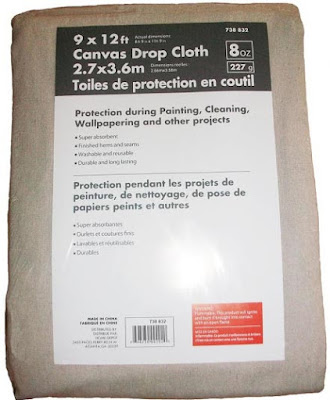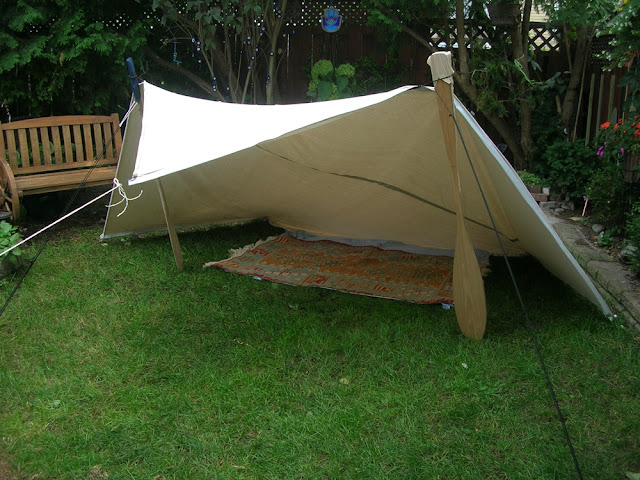Along with a canvas bedroll cover, I intend to use the heavier canvas tarp as a basic canoe shelter in the shoulder season when flies are at minimum and a warming fire can be confidently built to reflect heat.
Anyway, many bushcraft sites discuss using canvas painter's drop cloths as an affordable base material. Something like this...
9x12 Drop Cloth from local Home Depot
I've read conflicting reports that the 8oz plain weave drop cloths from hardware stores are too loosely woven to be effective shelters in heavy rain. Others say the weave can be tightened by hot washing and drying a few times before applying a basic waterproofing agent. Just when I was about to pull the trigger and buy one, I found another brand being offered on sale with a much larger coverage of 12'x14'. Not only that, it was woven with what appeared to be a tighter twill weave. Here's a web image of the brand (although this is a pic of their 8'x12')
Bennett Brand Twill Woven Drop Cloth
I like the versatility of a square tarp that can be pitched in a variety of ways. Most notably, a type known as the "Adirondack Wind Shed" is a favourite because one can sleep laterally warmed by a fire and have a exposed view.
Adirondack Wind Shed Pitch
http://www.survivalprimer.com/Tarp%20Shelters%20-Macpherson.htm
http://www.survivalprimer.com/Tarp%20Shelters%20-Macpherson.htm
This is very reminiscent of a smaller Whelen Lean To shelter as demonstrated in the following YouTube video:
So with this goal in mind, the project was begun. First the tarp was washed twice in hot water and machined dried with high heat to "tighten the weave". Not sure if this was necessary for this twill woven drop cloth but I followed the advice of posters on forums who suggested this be done before any cutting and modifications to the drop cloth take place.
Next the huge tarp was draped over the work station in the basement (aka ping pong table). One interesting thing was that the single "centre" seam on this 12'x14' behemoth was not actually centered on the tarp - instead it was around 4' from one edge.
Huge Tarp covering the table
I laid out the tarp and marked where it would be cut with masking tape to result in a 10x10 square. Given that the outer edges were already stitched with a basic seam, the cuts were positioned so that only 2 sides would be raw edged after cutting.
Marked out with masking tape
After checking out the measurements, the drop cloth was cut out. Keeping in mind that I don't have a sewing machine, at this stage I moved on to the waterproofing process and had plans to deal with the raw edges later.
I had obtained a bottle of NikWax Cotton Proof - a wash in formula for cotton canvas gear years ago thinking I would use it on the restored canvas Woods 200 pack. The Nikwax didn't seem to have an expiration date so figured now would be the time use this thing. I followed the hand washing instructions listed on the label which involved using the whole bottle (300 ml) while sloshing the tarp around in giant tub .
About to waterproof with Nikwax Cotton Proof
Afterwards, the tarp was transfered to a smaller 5 gallon bucket, submerged and soaked in the milky white solution for an additional 5 minutes.
Soaking in a 5 gallon bucket
The solution was then drained and the tarp lightly rinsed off with the hose. The tarp was then hung and air dried since I was worried the tumbling action of the dryer would further fray the unfinished cut edges. Luckily a breezy weather day took care of the drying process fairly quickly.
Hung up to dry
It was then brought back in to deal with the raw cut edges and centre seam. Like I said, we don't have a sewing machine but figured I could do a quick temporary job on the seams with pretty strong duct tape. I have a roll of white Gorilla tape that is pretty impressive stuff. Of course, nothing will properly replace the need for stitched edges but for the time being simply folding the raw edges in some of this heavy duty tape did the trick until I can get a used sewing machine and learn how to use it. A strip was also taped to the underside of the off centered seam.
For tie outs, I just used the old method of marbles and a little cordage. In total 8 of these were used so that there were tied out points every 5'. The beauty of this crude system is that the tie out positions can moved anywhere on the tarp for some pretty interesting pitches (another post about that soon).
Tie out with a marble and 3mm static cord. Duct taped edge on bottom
Here is the tarp all folded up. Yes it is bulkier than silnylon. Yes it is heavier. But I plan to get more the one usage out of this by using it as my pack cloth for the tump roll method described here and will likely use it on minimal portaging trips
Never been great at folding
With some free time days later, it was set it up in the backyard to give the waterproofing a quick test run. While most sites show the "Adirondack Wind Shed" pitched with a horizontal ridge line tied between trees, I wanted to see if it could be free standing using paddles as supports. On the left is the partially completed Sassafras Penobscot (version 2) and on the right is the Sassafras Tripper blank that has yet to be carved. Here is the result with 4 ground stakes and 2 guylines lines for support. The awning is tied out to patio table for this pic, but my intention would be to have the overturned canoe serve as an anchor point when out in the field.

You might've notice the blue and cream nylon things on the top of the paddle grips. This was my temporary solution for paddle tarp cups posted about earlier. Once I got the system figured out, they really allowed for better tarp pitching that just tying lines to the awkwardly shaped grips.
Basically I'm re-purposing some narrow nylon bags that I use for stakes and guyline cordage. Each of the nylon bags has a small rock tied with cord around the side. The bag with this tied rock is then is placed upside down over the paddle grip. The cord loops of the tarp are simply slipped over this rock and then the paddle placed vertically into position. When the guy lines are secured to the stake bags' drawstring and tensioned, the whole thing is pretty solid.
Here is a closeup if none of that made sense...
Tarp loop hooked over rock tied to stake bag; guyline tensioned on bag's drawcord
As an extra bit, another line was run between the 2 paddles and tensioned to support the "awning" but giving the heavier weight of the canvas, there is a pronounced curve. When I did this setup months ago with my 10x10 silnylon tarp, the awning was flatter. Still I can live with it in calmer weather.
This pitching style creates a sloped rear to allow for coverage in modest rain with a height of just over 4 feet at the awning. As a bit of scale, my wool kilim is roughly 65" inches long. Lengthwise, there's more than enough space under there for my bedroll and some gear.
After leaving it out overnight to see if any winds would slacken the line, I was pleasantly surprised to see that the thing didn't budge. This included a visit by the local racoon gang living in my neighbour's shed. One of them tried to climb up the backside and left his muddy paw prints on the tarp
Raccoon prints on the back side
Anyway, some water was sprayed on with the garden hose and it looks like the Nikwax coating did its job. Water droplets immediately beaded up and flowed down the back of the tarp
Waterproofing wash beading water droplets
I'm pretty happy with the way it turned out for a piece of homemade gear made for minimal cost. In another post, I'll pitch it in a few different ways (with and without paddle supports) and report back.
Another View




















2 comments:
Great post, and yet an other thing I might have to try!! But I would love to find good quality canvas that would be in the 5-6 oz some thing as good a what snow trekker tents use!! Since you are the master of searching things and I'm not, let me know if you ever find such a thing!
Thank you
David
Effort is much appreciated. Canvas is indeed a good material for tarps as it is breathable and prevents condensation buildup. Anyhow, waterproof cotton canvas tarps dyed in olive green color are readily available at Canvas Redux. https://canvasredux.ca/product/tarpaulins/
Post a Comment